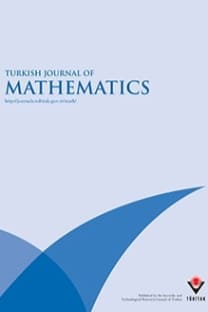Rings in which strongly prime right ideals are finitely generated
Bu çalışmada her kuvvetli asal sağ ideali sonlu üretilmiş olan halkaların bazı özellikleri araştırılmış ve böyle halkaların sağ Noether halkası olması için yeterli koşullar verilmiştir.
Kuvvetli asal sağ idealleri sonlu üretilmiş halkalar
Some properties of rings in which every strongly prime right ideal is finitely generated will be investigated, and sufficient conditions for such rings to be right noetherian will be given. Let R be an s-unital ring (i.e., a $in$ aR $cap$ Ra for each a $in$ R) and I($neq$ R)a right ideal of R. If, for each right ideals A and B of R, AB $subseteq$ I implies that either A $subseteq$ I or B $subseteq$ I, then I is called a prime right ideal (or equivalently, if a R b $notsubseteq$ I whenever a and b do not belong to I). I is strongly prime if, for each a and b in R, aIb $subseteq$ I and ab $in$ I imply that either a $in$ I or b $in$ I. It is known that a strongly prime right ideal is prime ([1]). In [4], Michler has proved that a ring with unity is right noetherian if and only if every prime right ideal of R is finitely generated. In this paper we shall consider s-unital rings in which every strongly prime right ideal is finitely generated, and give sufficient conditions for such rings to be right noetherian. In doing so, we shall greatly use Michler's techniques. In what follows, p(R) (resp., sp(R)) will denote the set of all prime (resp., strongly prime) right ideals of an s-unital ring R, and C(S) the complement of a nonempty subset S of R. Before starting with our main results, let's make some observations on the elements of sp(R). As is known, I $in$ p(R) if and only if C(I) is an m-system. Now we are going to introduce a k-system which will help us describe the elements of sp(R). Let S be a nonempty subset of a ring R. We say that S is a k-system if a,b $in$ S implies that either ab $in$ S or there exists s $notin$ S such that asb $in$ S. Evidently, if I is an ideal of a ring, then C(I) is a multiplicative system if and only if it is a k-system.
